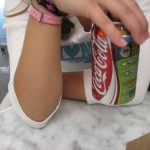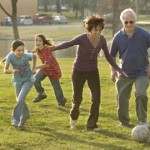healthy kids & families
Nutrition for Teens
 Adolescence seems to be synonymous with erratic eating habits as the typical teenager’s life fills up with friends, after-school activities and homework. Teens have the freedom to make their own choices, and are eating out more, visiting fast food restaurants more often, and getting food from school vending machines.
Adolescence seems to be synonymous with erratic eating habits as the typical teenager’s life fills up with friends, after-school activities and homework. Teens have the freedom to make their own choices, and are eating out more, visiting fast food restaurants more often, and getting food from school vending machines.
Dietary Guidelines for Teenagers
Adolescence is also a time of rapid growth and development that makes healthy eating habits even more important. Therefore, it is critically important that teenagers are encouraged to make nutritious food choices.
Calories
Due to all the growth and activity, adolescent boys need 2,500-2,800 per day, while girls need around 2,200 per day. It’s best to get these calories from lean protein, low-fat dairy, whole grains, and fruits and veggies.
Protein
In order for the body to grow and maintain muscle, teens need 45-60 grams per day. Most teenagers easily meet this need from eating meat, fish, and dairy, but vegetarians may need to increase their protein intake from non-animal sources like soy foods, beans, and nuts.
Calcium
The foundation for a lifetime of strong bones is built during the teen and young adult years until about age 30. This represents their peak bone mass – the strongest their bones will ever be. Many teens do not get sufficient amounts of calcium, leading to weak bones and osteoporosis later in life. Encourage teens to cut back on soda and other overly-sugary foods, which suck calcium from bones. The 1,200 mg of calcium needed per day should come from dairy, calcium-fortified juice and cereal, and other calcium-rich foods such as sesame seeds and leafy greens like spinach.
Iron
Iron deficiency can lead to anemia, fatigue, and weakness. Boys need 12 mg each day, and teen girls, who often lose iron during menstruation, need 15 mg. Iron-rich foods include red meat, chicken, beans, nuts, enriched whole grains, and leafy greens like spinach and kale.
 Cut Soda Drinks
Cut Soda Drinks
If your kids regularly drink fizzy drinks, they have a greater risk for a number of health problems including obesity, type 2 diabetes and even weaker bones. Cola drinks are a particularly poor choice, as they contain phosphoric acid which can have particularly bad effect on bone health. Some studies have linked soft drinks with an increased risk of bone fracture and a reduction in bone mineral density in children. Drinking soft drinks regularly, particularly in adolescent girls, has been linked to osteoporosis in later life.
Tips for Parents
Remind teenagers to eat breakfast, lunch and dinner
Skipping meals does not help with weight loss and it will keep them from getting all the nutrients they need.
 Model good behavior
Model good behavior
Eat well, exhibit a healthy attitude toward food, display a good body image and lead an active lifestyle yourself!
Portion control
Acknowledge that teenagers will eat fast foods, yet encourage buying the smallest portion sizes available and sharing a meal with a friend. Also, encourage teenagers to make beverage choices that are nutritious, such as seltzer water and low-fat milk, instead of obesity causing sodas.
Encourage nutrition label reading
Emphasize key teen nutrients that may be in short supply – such as calcium and iron. Starting the day with a bowl of cereal with milk is a great way for teens to get more calcium.
Stay Active
Encourage teenagers to choose an activity they enjoy and to exercise for at least 30 minutes to 60 minutes most days of the week.
 Resources for Teenagers
Resources for Teenagers
Girl Health helps girls (ages 10 to 16) learn about health, growing up, and issues they may face. Girlshealth.gov promotes healthy and positive behaviors in girls, giving them reliable and useful health information in a fun, easy-to-understand way.
Teens Health is part of the KidsHealth family of websites. These sites, run by the nonprofit Nemours Center for Children’s Health Media, provide accurate, up-to-date health information designed just for teenagers.
Source: HELPGUIDE.ORG in collaboration with Harvard Nutrition Publications and Parents for Health

